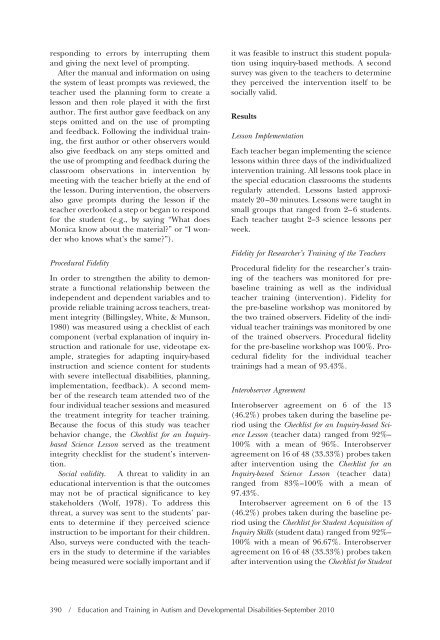Education and Training in Autism and Developmental Disabilities
Education and Training in Autism and Developmental Disabilities
Education and Training in Autism and Developmental Disabilities
You also want an ePaper? Increase the reach of your titles
YUMPU automatically turns print PDFs into web optimized ePapers that Google loves.
espond<strong>in</strong>g to errors by <strong>in</strong>terrupt<strong>in</strong>g them<br />
<strong>and</strong> giv<strong>in</strong>g the next level of prompt<strong>in</strong>g.<br />
After the manual <strong>and</strong> <strong>in</strong>formation on us<strong>in</strong>g<br />
the system of least prompts was reviewed, the<br />
teacher used the plann<strong>in</strong>g form to create a<br />
lesson <strong>and</strong> then role played it with the first<br />
author. The first author gave feedback on any<br />
steps omitted <strong>and</strong> on the use of prompt<strong>in</strong>g<br />
<strong>and</strong> feedback. Follow<strong>in</strong>g the <strong>in</strong>dividual tra<strong>in</strong><strong>in</strong>g,<br />
the first author or other observers would<br />
also give feedback on any steps omitted <strong>and</strong><br />
the use of prompt<strong>in</strong>g <strong>and</strong> feedback dur<strong>in</strong>g the<br />
classroom observations <strong>in</strong> <strong>in</strong>tervention by<br />
meet<strong>in</strong>g with the teacher briefly at the end of<br />
the lesson. Dur<strong>in</strong>g <strong>in</strong>tervention, the observers<br />
also gave prompts dur<strong>in</strong>g the lesson if the<br />
teacher overlooked a step or began to respond<br />
for the student (e.g., by say<strong>in</strong>g “What does<br />
Monica know about the material?” or “I wonder<br />
who knows what’s the same?”).<br />
Procedural Fidelity<br />
In order to strengthen the ability to demonstrate<br />
a functional relationship between the<br />
<strong>in</strong>dependent <strong>and</strong> dependent variables <strong>and</strong> to<br />
provide reliable tra<strong>in</strong><strong>in</strong>g across teachers, treatment<br />
<strong>in</strong>tegrity (Bill<strong>in</strong>gsley, White, & Munson,<br />
1980) was measured us<strong>in</strong>g a checklist of each<br />
component (verbal explanation of <strong>in</strong>quiry <strong>in</strong>struction<br />
<strong>and</strong> rationale for use, videotape example,<br />
strategies for adapt<strong>in</strong>g <strong>in</strong>quiry-based<br />
<strong>in</strong>struction <strong>and</strong> science content for students<br />
with severe <strong>in</strong>tellectual disabilities, plann<strong>in</strong>g,<br />
implementation, feedback). A second member<br />
of the research team attended two of the<br />
four <strong>in</strong>dividual teacher sessions <strong>and</strong> measured<br />
the treatment <strong>in</strong>tegrity for teacher tra<strong>in</strong><strong>in</strong>g.<br />
Because the focus of this study was teacher<br />
behavior change, the Checklist for an Inquirybased<br />
Science Lesson served as the treatment<br />
<strong>in</strong>tegrity checklist for the student’s <strong>in</strong>tervention.<br />
Social validity. A threat to validity <strong>in</strong> an<br />
educational <strong>in</strong>tervention is that the outcomes<br />
may not be of practical significance to key<br />
stakeholders (Wolf, 1978). To address this<br />
threat, a survey was sent to the students’ parents<br />
to determ<strong>in</strong>e if they perceived science<br />
<strong>in</strong>struction to be important for their children.<br />
Also, surveys were conducted with the teachers<br />
<strong>in</strong> the study to determ<strong>in</strong>e if the variables<br />
be<strong>in</strong>g measured were socially important <strong>and</strong> if<br />
it was feasible to <strong>in</strong>struct this student population<br />
us<strong>in</strong>g <strong>in</strong>quiry-based methods. A second<br />
survey was given to the teachers to determ<strong>in</strong>e<br />
they perceived the <strong>in</strong>tervention itself to be<br />
socially valid.<br />
Results<br />
Lesson Implementation<br />
Each teacher began implement<strong>in</strong>g the science<br />
lessons with<strong>in</strong> three days of the <strong>in</strong>dividualized<br />
<strong>in</strong>tervention tra<strong>in</strong><strong>in</strong>g. All lessons took place <strong>in</strong><br />
the special education classrooms the students<br />
regularly attended. Lessons lasted approximately<br />
20–30 m<strong>in</strong>utes. Lessons were taught <strong>in</strong><br />
small groups that ranged from 2–6 students.<br />
Each teacher taught 2–3 science lessons per<br />
week.<br />
Fidelity for Researcher’s <strong>Tra<strong>in</strong><strong>in</strong>g</strong> of the Teachers<br />
Procedural fidelity for the researcher’s tra<strong>in</strong><strong>in</strong>g<br />
of the teachers was monitored for prebasel<strong>in</strong>e<br />
tra<strong>in</strong><strong>in</strong>g as well as the <strong>in</strong>dividual<br />
teacher tra<strong>in</strong><strong>in</strong>g (<strong>in</strong>tervention). Fidelity for<br />
the pre-basel<strong>in</strong>e workshop was monitored by<br />
the two tra<strong>in</strong>ed observers. Fidelity of the <strong>in</strong>dividual<br />
teacher tra<strong>in</strong><strong>in</strong>gs was monitored by one<br />
of the tra<strong>in</strong>ed observers. Procedural fidelity<br />
for the pre-basel<strong>in</strong>e workshop was 100%. Procedural<br />
fidelity for the <strong>in</strong>dividual teacher<br />
tra<strong>in</strong><strong>in</strong>gs had a mean of 93.43%.<br />
Interobserver Agreement<br />
Interobserver agreement on 6 of the 13<br />
(46.2%) probes taken dur<strong>in</strong>g the basel<strong>in</strong>e period<br />
us<strong>in</strong>g the Checklist for an Inquiry-based Science<br />
Lesson (teacher data) ranged from 92%–<br />
100% with a mean of 96%. Interobserver<br />
agreement on 16 of 48 (33.33%) probes taken<br />
after <strong>in</strong>tervention us<strong>in</strong>g the Checklist for an<br />
Inquiry-based Science Lesson (teacher data)<br />
ranged from 83%–100% with a mean of<br />
97.43%.<br />
Interobserver agreement on 6 of the 13<br />
(46.2%) probes taken dur<strong>in</strong>g the basel<strong>in</strong>e period<br />
us<strong>in</strong>g the Checklist for Student Acquisition of<br />
Inquiry Skills (student data) ranged from 92%–<br />
100% with a mean of 96.67%. Interobserver<br />
agreement on 16 of 48 (33.33%) probes taken<br />
after <strong>in</strong>tervention us<strong>in</strong>g the Checklist for Student<br />
390 / <strong>Education</strong> <strong>and</strong> <strong>Tra<strong>in</strong><strong>in</strong>g</strong> <strong>in</strong> <strong>Autism</strong> <strong>and</strong> <strong>Developmental</strong> <strong>Disabilities</strong>-September 2010

















